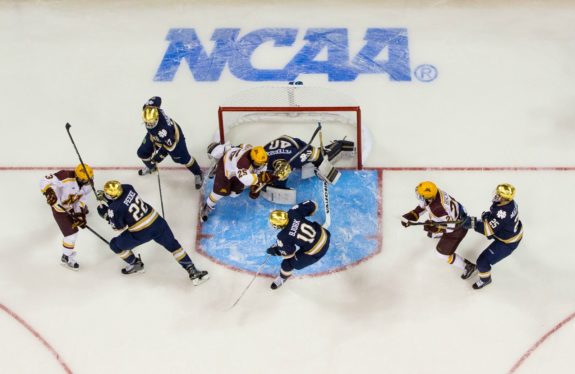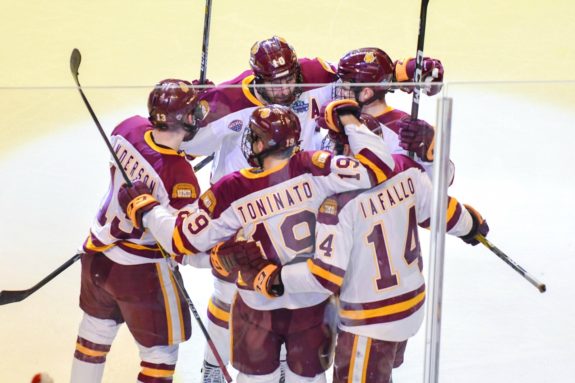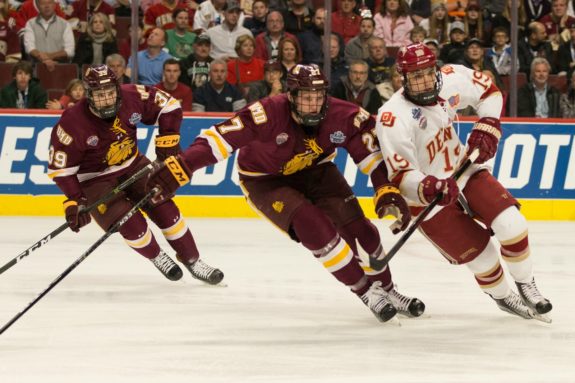The NCAA Men’s and Women’s Ice Hockey Rules Committee has been trying to alter their overtime rules after they noticed a crisis similar to the NHL’s shootout crisis: too many games were ending in ties. By December of last year, the league had seen a total of 59 ties. This offseason, the NCAA decided they were going to work to change that, as well as change the styles in which teams can earn back points in conference games.
A Call for Uniformity
Like all other college sports, NCAA hockey has rules that vary greatly from that of its respective professional league–for better or for worse. One of the options, which is for the worse, is games ending in ties. Games end in ties if the game remains tied after a five-minute 5-on-5 overtime period.
The 5-on-5 OT period is required but after that, in conference games, teams can use one of three different options in order to avoid and tie and earn points back.

Atlantic Hockey, the ECAC and Hockey East follow the simplest option that after the five-minute OT ends, the game ends in a tie and no extra points can be earned. The WCHA and NCHC do five-minutes of 3-on-3 OT and follow-up with a sudden-death shootout. Meanwhile, the Big Ten initiates a three-person shootout and advances to a sudden-death shootout if needed.
The varying standards for conferences can draw comparisons to the MLB with their use of a designated hitter in the American League but not in the National League. While a DH doesn’t impact the outcome of a game quite like the extra-point rules do, both have a distinct impact on the strategies of a team.
For the Big Ten, there would be more emphasis on recruiting shootout specialists since they only experience shootouts following OT, or maybe more drills would be centered around the goalies versus shooter situation in practice. And if they’re accustomed to working magic in shootouts, when it comes to non-conference games suddenly they’re got off-guard when all they have is an overtime period. And what if that game comes against an NCHC team that plays two periods of OT? What’s more, what if it’s against an ECAC team that only gets one period of OT usually?
The point is there are slight advantages and disadvantages given to teams depending on what conferences they play in.
A Revision on a Universal Rule
To try and smooth over these inconsistencies, the NCAA called for an end to these conference systems and to establish a uniform rule across the entire NCAA. The NCAA wanted to eliminate the extra-point option and go for one single overtime option that would decide if games ended in a tie, or a win/loss.
However, when it came time for their first proposal, the rules had slightly changed.
The NCAA proposed that the required first period of OT would no longer be 5-on-5, but 4-on-4. On top of this, they created an optional rule of allowing a three-on-three OT period and sudden death shootout to follow for an extra point within each conference, though conferences could opt to not use the rule at all.
“After a thorough discussion of the overtime process, and seeing the success experienced by the National Hockey League and others using four-on-four, we believe this change will be a positive step for NCAA hockey,” said Tom Anastos, chair of the committee and head coach of the men’s hockey team at Michigan State University.
By going 4-on-4 the NCAA would have very well seen an increase in goals and games ending in OT rather than a tie, much like the NHL did when they saw an issue of too many games going to shootouts. Despite going back on wanting just one OT period, the solution still posed only one extra-point method.

However, the rule had been fatally altered after hearing from their membership. The rule changed to a mimicking of their current systems. The 4-on-4 mandatory OT that was created to increase scoring was changed back to 5-on-5. On top of that, conferences would be able to choose to have a five-minute 3-on-3 OT period followed by a shootout or go straight to a shootout, bypassing the second OT.
As much as the NCAA beckoned for more regulation and uniform systems, their new solution does just the opposite. While the three options to gain back points have been cut down to two options (OT then shootout or just a shootout), there is still a lack of an overarching policy.
No Problems Solved
So what does the rule solve?
Quite honestly, nothing. The rule serves more comedic value at the sheer absurdity of the NCAA. The league called for a rule change to solve the issue of ties and unregulated points back options. Neither of those is getting solved.
The NCAA should take note of what the NHL is up to.
While the NHL is known for making mistakes, their rule changes to increase scoring has been the opposite of a mistake. The combination of enforcement of faceoff rules, the revision to the slashing penalty and 3-on-3 overtime makes everyone laugh at the fact they considered enlarging nets or shrinking equipment instead.
The original plan of 4-on-4 play in one OT was ideal. It would cause more goals to be scored and it would not be a difficult transition for teams; it would only decrease units by one player. It’s not as if teams are playing 3-on-3 and most of them hardly ever get caught with only three men on the ice outside of that OT period–teams get dropped to four players on a penalty kill, so it would be an easy transition.
And as for still having extra-point options, it’s an option that doesn’t need to exist. While it’s nice as a fan to be able to get free hockey or to be a coach and get your players the extra conditioning, the extra point is not necessary. Games that go into an extra-point scenario officially count as a tie in the overall standings and only impact conference standings. The impact it has is important but teams could easily function without it.
If anything, it pushes teams to reach for the extra-point instead of putting their necks out there and pushing for a win. This is because a loss in the extra-point system is worth one point instead of zero in regulation or a mandatory OT period.

The best option to solve that issue is eliminating the extra-point option altogether, something the NCAA had originally planned to do. Now teams will be willing to take chances and get the ‘W’ instead of a participation point, therefore cutting down on ties.
And if you can’t eliminate the extra-point, then make it so it’s hard to get to that point. Enforce 3-on-3 in the mandatory OT. It’s like when the NHL wanted to cut down on shootouts, how they did it was by making teams get through a dangerous 3-on-3 OT in order to get there. The same rules apply. Make the mandatory OT 4-on-4 or 3-on-3 and suddenly extra-point games will become sparse, and ties in out-of-conference games will fall too. It’s a win-win.
The NCAA knew what it was going into their proposal, which will be approved or rejected this coming Wednesday, July 25 in a rules conference, but have gone down a road in which their issues really won’t be solved at this rate, but maybe it’s a step in the right direction.